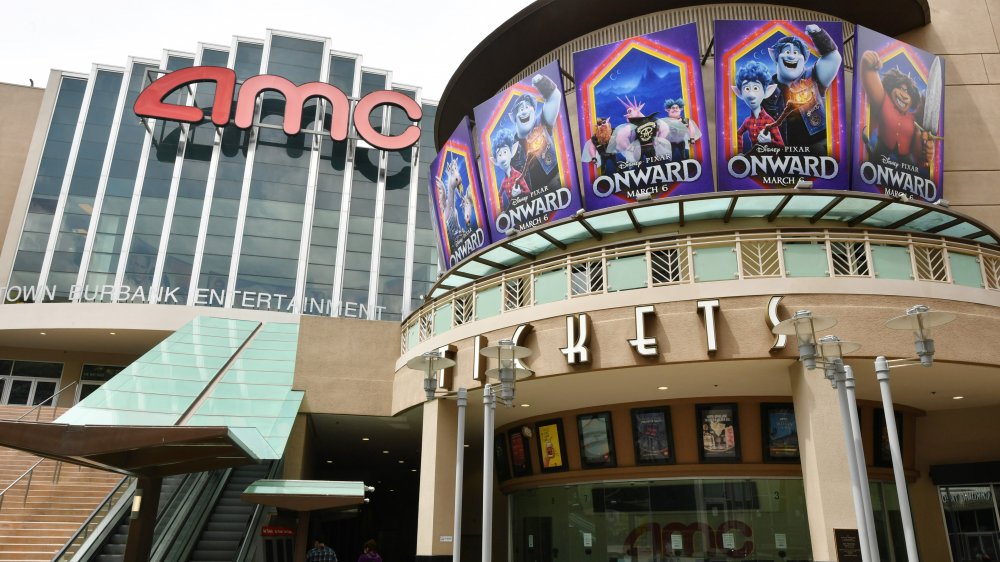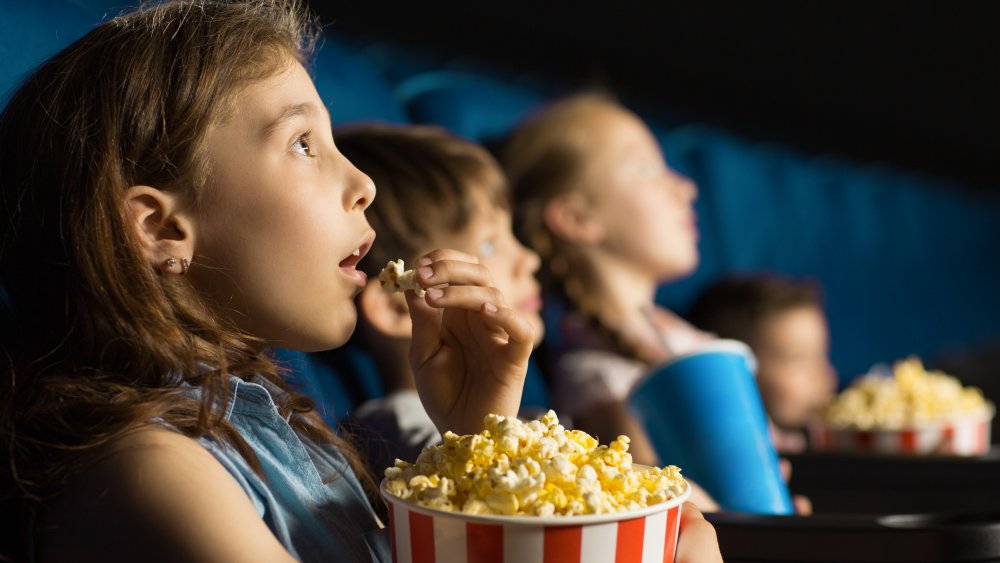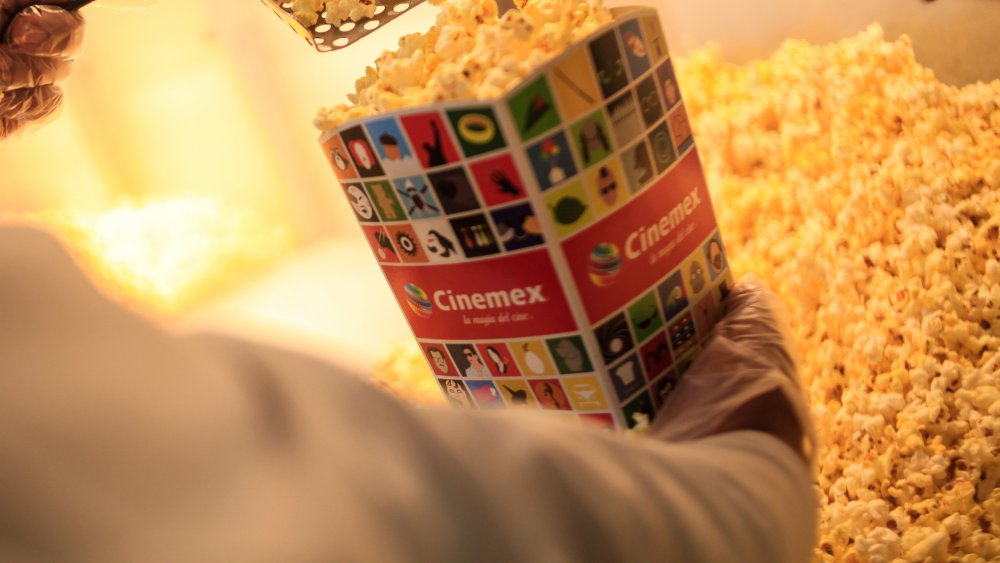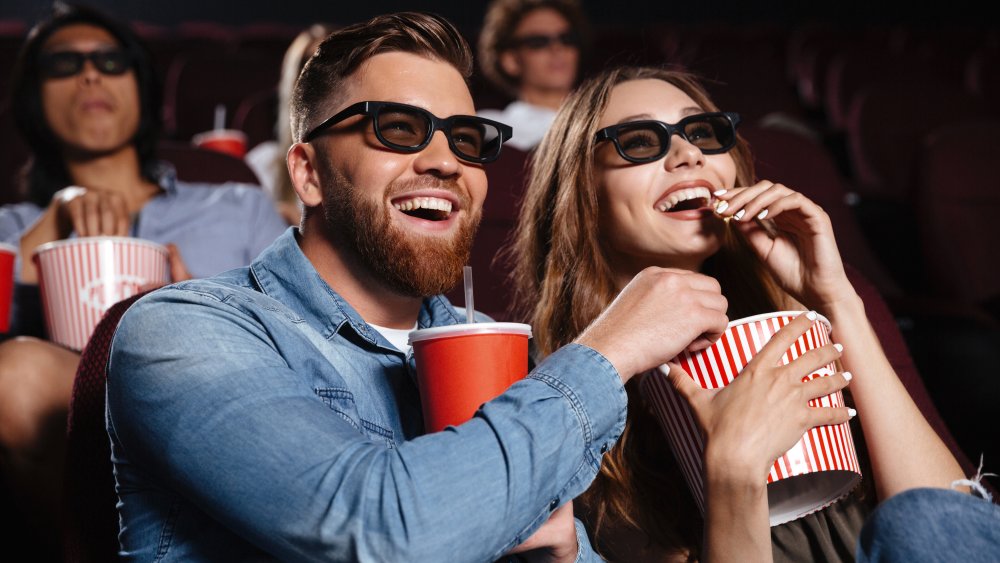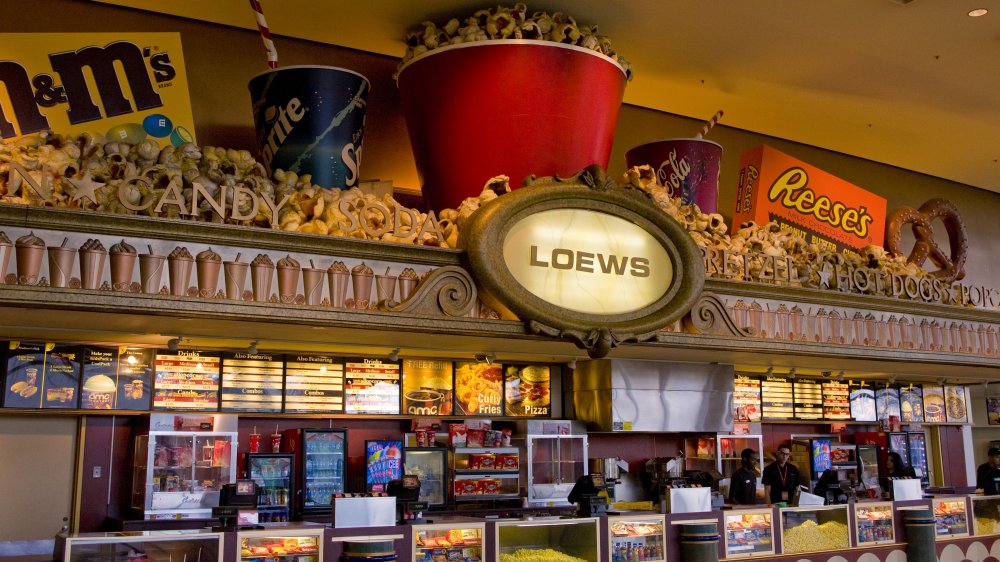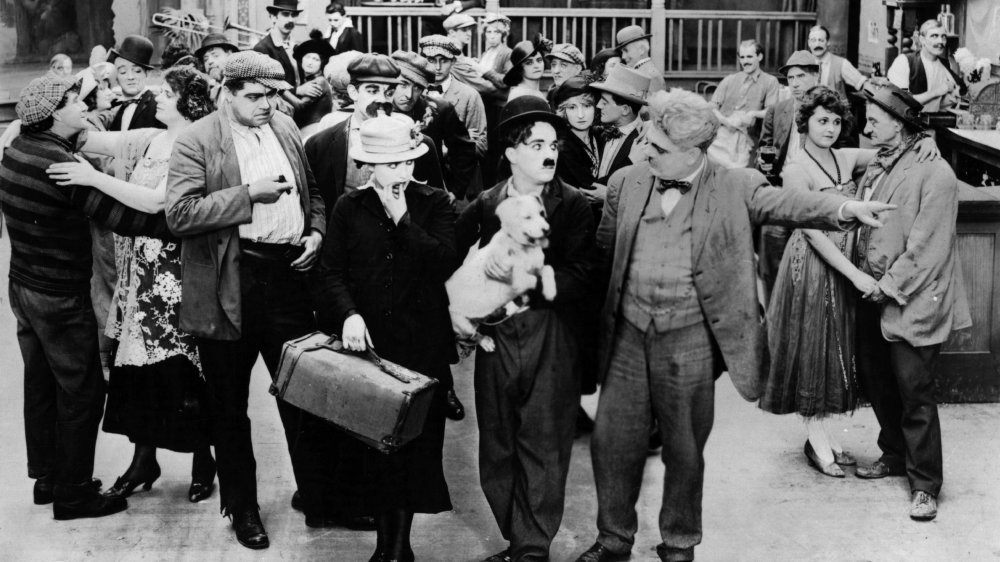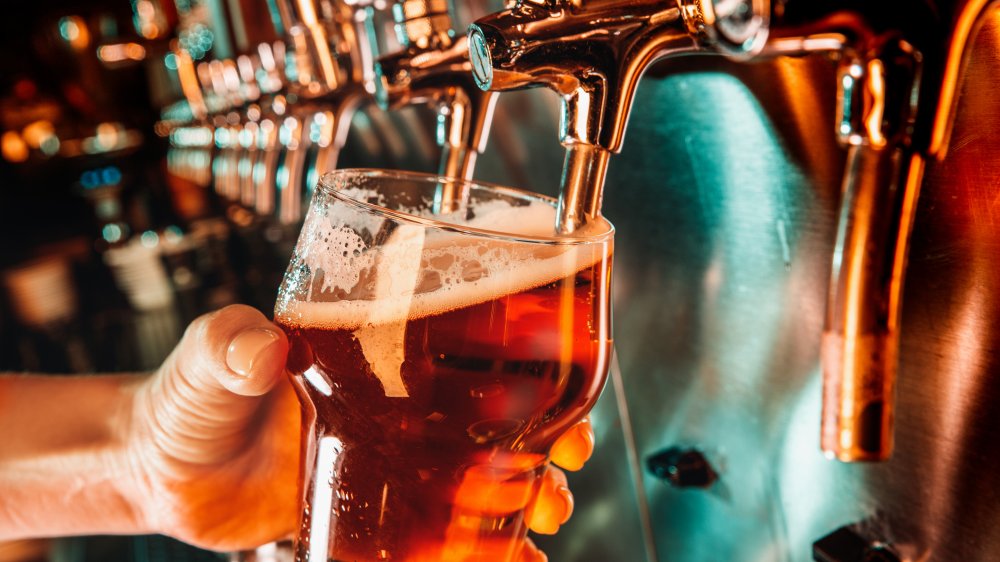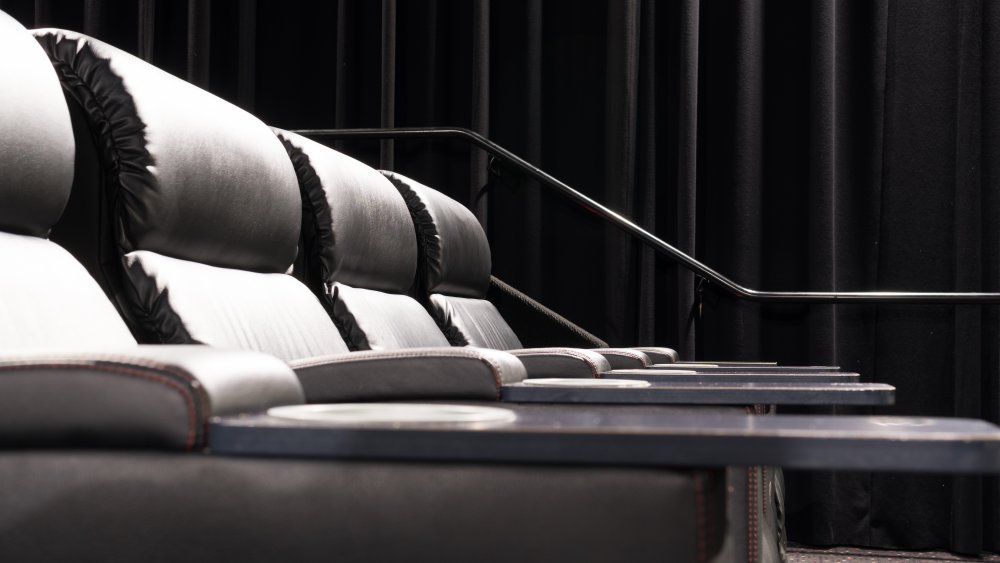Reasons Why Movie Theater Food Is So Expensive
In today's world of endless streaming platforms, where Oscar-nominated directors now produce Netflix-exclusive films, you're more likely to hang on the couch at home then spend a night out at the cinema. Who wants to bother with getting dressed and finding a parking spot, anyway? But when you do venture out for a movie at the theater, it doesn't take long to remember that there's still nothing quite like the old school magic of the movie-going experience.
It's the excitement of waiting for the lights to go down, the boom of speakers, and the act of taking in a story on the big screen with a shared audience. And is there any food more synonymous with an experience like freshly made popcorn at the movie theater? Even with a classic dinner and a movie date night combo, the strong scent of buttered popcorn at the box office is enough to make anyone's mouth water. And while we'd never condone lining your pockets and purses with dollar store candy and snacks, it can be pretty tempting to do exactly that once you take a look at the high menu prices for movie theater food. So, why exactly is movie theater food so expensive? There are actually quite a few reasons why movie theater food costs as much as it does.
Movie theaters can charge pretty much whatever they want for food
Sometimes the answers to life's great mysteries are frustratingly simple. It's pretty easy to do the math and notice that the cost of a bucket of popcorn and a large fountain drink can reach upwards of $15, which is often more than if you were to buy an entire box of microwave popcorn packs and a case of soda cans from a grocery store. So why such a discrepancy?
Simply put, movie theaters are a business just like any other. Unless you're sneaking food in, there isn't really any other competition for food once you're inside. In that sense, movie theaters can essentially charge whatever they want, simply because they can and customers will still pay for it. For instance, a pair of professors at Stanford and UC Santa Cruz even found that more often than not, concession sales were actually much higher during low-attendance periods. Meaning that more "committed" moviegoers were also more willing to consistently pay for movie theater food, no matter the film.
Inflation definitely plays a role in movie theater food prices
Ah yes, inflation, the great equalizer of money and price discrepancies. We've all had the older relative complaining about increased gas prices that once "only cost a nickel" back in their day. Or if you're lucky enough yourself (depending on your perspective) you may be old enough to have noticed market shifts in some of your favorite industries, like fast food, craft alcohol, or even general grocery store prices.
Just like any other market, movie theaters are not immune to the effects of economic shifts. In the last 20 years alone, the average cost of a movie ticket has more than doubled. In 1990, movie tickets were priced at around $4.22, while in 2019 the average cost of a ticket reached $9.16. And depending on where you live or what movie theater you prefer to see movies, that price can definitely be even higher. And just as movie ticket prices have increased over time, it is just as plausible that concession stand prices would also steadily climb right along with them.
But markups are usually the case when it comes to movie theater food
Even if the price tag for a box of Milk Duds, some nachos, and a blue Icee for a night out at the movies is definitely higher than it was in 1987, a "change in the times" statement about inflation just can't be the only reason. Markups, where anyone selling a good or service "marks" the price higher to cover overhead costs, are the basic ways a business makes a profit. But how much are movie theaters actually marking up concession stand items?
In his 2008 book Why Popcorn Costs So Much at the Movies, And Other Pricing Puzzles, Richard McKenzie, a former professor at the UC Irvine Merage School of Business, explored some of the specific markups present at most movie theaters. In popcorn alone he found a nearly 806 percent markup when comparing the average cost of around $8 for a large bucket at the movie theater with the 90 cents the raw goods actually cost. Even candy is usually double the price: a small bag of plain M&Ms sells for around $2 at Walmart while they can cost over $4 at the movie theater. And again, even though most customers know they're overpaying, it usually doesn't slow business down.
Food is a way for movie theaters to make money, without actually pricing people out
While movie ticket prices have certainly climbed upwards alongside concession stand items, it's still not quite at the same level. But why is that? Wouldn't it make the most sense for movie theaters to simply raise the price of admission, guaranteeing more money up front even if only half of all customers actually purchase food? Economist Ron Baker explained that by not setting the bar for entry too high, movie theater owners are actually able to segment their customers with a "two-part tariff" pricing strategy. It's the equivalent of paying an upfront cost for the opportunity to then purchase a product.
Customers like students and senior citizens are usually less likely to spend, and in most cases, receive some sort of up front discount to begin with on their tickets. However, "the theater owner doesn't want to turn these customers away, and hence keeps the box office price lower by charging higher prices to snack eaters," said Baker in a post on his company's blog. "What you are really buying when you purchase a movie ticket is an opportunity — a chance to enjoy the movie, or to enjoy it with popcorn."
And concession stands are usually where movie theaters actually profit
Let's say for the sake of argument, individual movie theaters actually wanted to raise their ticket prices. While it would be disastrous as a consumer, from a business standpoint it would actually make a lot of sense. Think of the price increases we would see for big blockbuster movie events like the latest Star Wars, Marvel movie, or popular animated children's feature. The thing is, movie theaters are tied to the movie studios distributing the films. The price of a movie ticket is split so that studios usually get around a 60 percent cut of ticket sales, though that can change since movie theaters and studios negotiate the arrangement on an individual basis. But in every case, the studio is taking the majority of money that comes from tickets.
For movie theaters, that leaves an average profit margin at around 40 percent. Factor in that they also have to cover the overhead costs of operation like electric bills, employee salaries, projectors, seating and more, then it's no secret why concession stands become the (literal) bread and butter for movie theaters. All in all, concessions end up representing around 40 percent of movie theaters' profits, even though they only account for about 20 percent of revenues.
Prices in movie theater food go all the way back to a 1948 Supreme Court case
So, how did movie theaters and movie studios end up coming to terms on a split for ticket sales? For a long time, it was actually pretty one-sided. In the early days of cinema, studios actually owned most of the movie theaters in one way or another. It allowed them to not only distribute movies to whatever areas they wanted, but to charge whatever they wanted as well, maximizing total profits for the studios. Years of antitrust lawsuits from independent filmmakers like Charlie Chaplin helped to chip away at the issue, until finally the U.S. Supreme Court stepped in. In 1948 the United States V. Paramount helped to break up the studio's monopoly on the industry, opening the doors for more independent producers and movie theaters to have a chance to get in on the action.
But, interestingly enough, over 50 years later the outcome still affects how movie theaters and movie studios split profits. While most movie theaters and studios agree to around a 60-40 split in favor of studios, there are still some contingencies left over from 1948 that create an interesting angle. The studio still receives the majority of ticket sales in the first few weeks of a movie's run, sometimes up to 95 percent of the gross ticket sales, falling steadily each week after. Given the short end of the deal movie theaters are getting in this case, it feels like you're actually supporting the underdog with that $14 nacho plate.
Movie theater food is like concessions at any other live event
It might also help to think of a movie theater concession stand like you would any other concession stand at a live concert or sporting event. Sure, it's not actually helping your wallet, but a little mental gymnastics to ward off buyer's regret never really hurts too much. Besides, the NFL has seen a steady increase in concession stand prices for products like beer, hot dogs, and soft drinks since 2006. And that's not even including the revenue from jersey sales and other onsite merchandise and souvenirs every single gameday.
Going to the movies might not be the same as watching your favorite performer put on a live show, and it's definitely not comparable to the playoff-atmosphere of an in-person sporting event. But the cinematic theater experience still holds a special place in our culture. And in a time where it's just as easy, and tempting, to put off the movie theater in favor of a Netflix binge, now more than ever going to the movies can feel like a more momentous occasion.
Bars in movie theaters are also driving prices
Even the best movie theater snack bars could use an upgrade, especially as general movie theater attendance has fluctuated in recent years. Now the addition of alcohol is adding an interesting wrinkle to movie theater concession stands. And why wouldn't it? In one of the early scenes of Quintin Tarantino's Pulp Fiction, John Travolta's character, Vincent, explains to Samuel L. Jackson's Jules some of the subtle differences between America and Amsterdam. One of the first examples he gives, along with the classic "Royale with Cheese" line, is the opportunity to buy a beer in European movie theaters. "And I don't mean in a paper cup," he says. "I'm talkin' 'bout a glass of beer."
In 1994, beer in a movie theater was just a fantasy. Now, it's a potentially game-changing aspect for both customers who want to enjoy a film with a cocktail, and movie theaters looking to maximize their profits. AMC Theater VP George Patterson was quoted in a 2017 CinemaBlend article, calling alcohol the industry's fastest-growing amenity: "Dollar for dollar, alcohol doesn't cannibalize candy, soda or popcorn," he said. "If I put a bar in, I can almost guarantee my food and beverage revenue will go up. Over 70 percent of our guests are over the age of 21."
And a 'luxury theater' boom adds even more dining options at the movies
Nowadays plenty of movie theaters are going far beyond a bar setup to up the value of an evening at the movies. It's growing pretty common for customers to have the option of skipping the junk food altogether in favor of more upscale dining options, including full meals brought to their seats by a dedicated waitstaff. Movie theaters are also upping the ante with improved amenities like full, plush leather recliners and private viewing boxes. That's a pretty significant upgrade from the days of battling for elbow room on shared armrests, or making too much noise trying to open a bag of candy. And it all goes back to the idea of taking advantage of a captive audience: if movie theaters can ensure you stay longer, you're more likely to spend more money on products. And how can they accomplish that? By creating the ultimate viewing experience, one that's better than the living room couch dominating the streaming era.
"It has to be a complete experience, with dinner, drinks and a movie, all in one place, so you're not tempted to leave," Wheeler Winston Dixon, Ryan professor of film studies at the University of Nebraska told the The Republic in 2017. "It can be a date night for Mom and Dad, or the whole family, complete with reserved seating and super reclining chairs."
